
Rib Fracture Repair Systems Market Size, Share & Trends Analysis Report By Product (U Plate, Anterior Plate), By Material (Titanium, PEEK), By End-use (Hospitals, Outpatient Facilities), By Region, And Segment Forecasts, 2024 - 2030
- Report ID: GVR-4-68040-296-8
- Number of Report Pages: 150
- Format: PDF, Horizon Databook
- Historical Range: 2018 - 2023
- Forecast Period: 2024 - 2030
- Industry: Healthcare
Rib Fracture Repair Systems Market Trends
The global rib fracture repair systems market size was estimated at USD 273.54 million in 2023 and is projected to grow at a CAGR of 4.7% from 2024 to 2030. The market encompasses a wide range of products and technologies designed to treat and manage rib fractures and is driven by several factors, including increasing incidence of rib fractures, technological advancements, and growing demand for minimally invasive surgical procedures. As per the Medscape report published in January 2023, simple rib fractures are the most common injuries resulting from blunt chest trauma, accounting for over 50% of thoracic injuries caused by non-penetrating trauma. Notably, around 10% of individuals admitted due to blunt chest trauma experience one or more rib fractures.
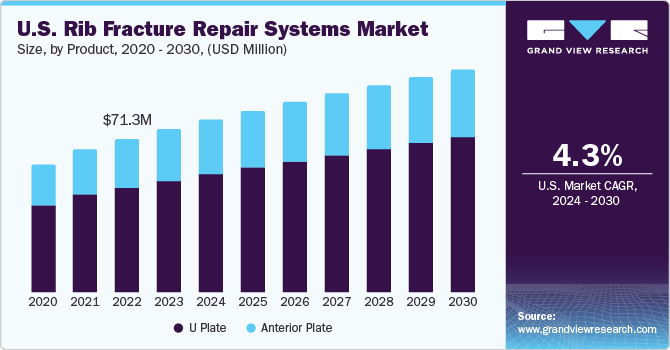
An increasing aging population, which is more susceptible to bone fractures, and a growing number of accidents & falls are driving market growth. In addition, improved diagnostic techniques have led to the early detection and treatment of rib fractures, further fueling market growth. According to a National Institute of Health (NIH) article published in 2023, it is estimated that the annual number of individuals experiencing rib fractures ranges from 1.5 million to 2 million. As the population continues to age, there has been a consistent increase in the percentage of middle-aged and elderly people experiencing rib fractures each year, contributing to market growth.
With a higher prevalence of rib fractures among the elderly, there is an increasing demand for advanced and effective repair solutions. This trend is expected to drive innovation and growth in the market as manufacturers and healthcare professionals work together to develop more efficient, less invasive, and patient-friendly repair systems tailored to the specific needs of the aging population. A study published in the JAMA Network in 2020 reveals that rib fractures affect about 15% of trauma patients and are present in approximately two-thirds of chest injury cases. These fractures often lead to significant complications (48%) and mortality rates (22%) in adults. In addition, among elderly patients (aged 60 and above) who succumbed to chest trauma, 55% had no injuries worse than rib fractures. As the global population ages, the demand for rib fracture repair systems is expected to rise, subsequently driving market growth.
Furthermore, technological advancements in orthopedics have also played a significant role in market growth. The development of innovative products and techniques, such as minimally invasive surgical procedures, has improved patient outcomes and reduced recovery times. These advancements have made it easier for patients to access and recover from rib fracture treatments, thereby increasing the demand for rib fracture repair systems.
Market Concentration & Characteristics
The rib fracture repair systems industry exhibits a moderate level of concentration, primarily due to a few well-established players dominating the market share. This market concentration is influenced by factors such as technological advancements, regulatory requirements, and the need for specialized expertise in developing and manufacturing these systems. The moderate level of competition allows emerging companies to enter the market and innovate, driving growth and diversification in the long run.
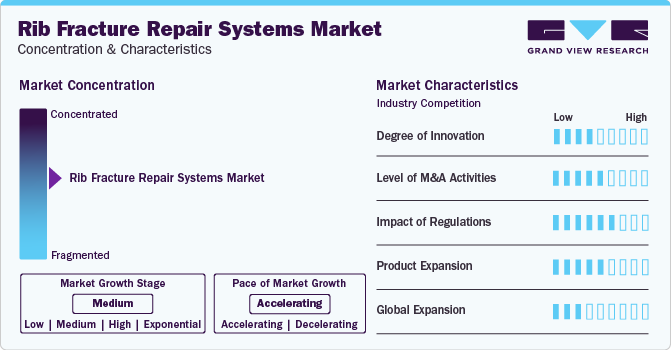
The degree of innovation in the rib fracture repair systems market can be considered moderate, as it involves balancing technological advancements and the need for improved patient outcomes. This moderate level of innovation is driven by the growing demand for better treatment options for patients at increased risk of rib fractures.
Regulations play a significant role in shaping the market. They ensure product safety, efficacy, and quality while promoting fair competition among manufacturers. These regulatory guidelines may affect market entry barriers, pricing, and innovation, influencing the overall growth and dynamics of the market. In addition, they help protect patients by ensuring the availability of reliable and effective products, ultimately contributing to better healthcare outcomes.
In the market, mergers and acquisitions (M&A) activity can be considered moderate. This is driven by companies seeking to expand their product portfolios, enhance their technological capabilities, and gain a stronger foothold in the competitive market. M&A activities contribute to market consolidation and shape the competitive landscape, with both established players and emerging companies participating in these strategic moves to strengthen their positions.
Product expansion in the market experiences moderate activity. Companies continuously invest in research and development to create innovative solutions and improve existing products, catering to the evolving needs of healthcare professionals and patients. For instance, in January 2024, Able Medical Devices announced the FDA clearance for its Valkyrie RIB System, which significantly strengthens its offerings in the cardiothoracic and trauma domains. The Valkyrie Thoracic Fixation System acts as an extension for the innovative one-time use PEEK device and is designed for applications such as stabilizing and fixing chest wall fractures, aiding in reconstructive surgical procedures, addressing trauma cases, and facilitating planned bone resection procedures. This moderate pace of product expansion is driven by factors such as technological advancements, regulatory requirements, and the growing demand for effective and minimally invasive fracture repair methods.
Global expansion in the market exhibits a moderate level of activity. Companies strive to penetrate international markets by forging strategic partnerships, establishing distribution networks, and adhering to regional regulatory norms. The moderate pace of global expansion is influenced by factors such as the increasing prevalence of fractures and companies' desire to diversify their geographical reach.
Product Insights
The U plate segment accounted for the largest revenue market share of 68.57% in 2023 and is anticipated to register the fastest CAGR during the forecast period. The U plate segment within the rib fracture repair system has experienced notable growth attributed to several key drivers. Advancements in medical technology have facilitated the development of more efficient and versatile U plate designs, enhancing their effectiveness in stabilizing rib fractures. In addition, key market players in the market are expanding globally, leveraging strategic partnerships, acquisitions, and distribution agreements to penetrate new regions. This expansion is driving the growth of the U-plate market by increasing accessibility and awareness of advanced fracture repair solutions worldwide. For instance, in November 2021, OsteoMed unveiled the launch of a new logistics center in Madrid, Spain. This strategic move aims to elevate customer experience within the European Union (EU) by expediting delivery times and minimizing supply chain risks. Moreover, the rising incidence of traumatic injuries, including vehicular accidents and falls, has expanded the patient pool requiring rib fracture repair, thereby driving market growth.
The anterior plate segment is expected to grow significantly over the forecast period, primarily due to strategic partnerships and technological advancements. Collaborations between medical device companies and healthcare institutions facilitate the development of innovative anterior plate designs, enhancing their efficacy in stabilizing rib fractures. For instance, in March 2020, Acumed, a medical device company, partnered with Acute Innovations, which specializes in innovative solutions for complex traumatic chest wall injuries. The collaboration aims to develop industry-first products by combining their dedication to Education, Evidence, Innovation, and Quality. Acute Innovations' product portfolio provides surgeons with solutions for rib fractures related to traumatic injury and technologies for chest wall reconstruction. Furthermore, advancements such as improved materials and minimally invasive techniques are driving adoption rates, fueling the expansion of the anterior plate market in rib fracture repair systems.
End-use Insights
The outpatient facilities segment accounted for the largest revenue market share of 54.51% in 2023 and is anticipated to register the fastest growth over the forecast period. Factors driving this growth include advancements in materials and a shift towards outpatient care for quicker recovery and cost-efficiency. Outpatient facilities offer convenient, specialized care for rib fractures, reducing the need for hospitalization and providing patients more personalized treatment options. For instance, a November 2022 report published by Cureus highlights outpatient rib fracture fixation as a safe and effective treatment option. One of the key advantages of this approach is the reduced costs for both patients and the healthcare system.
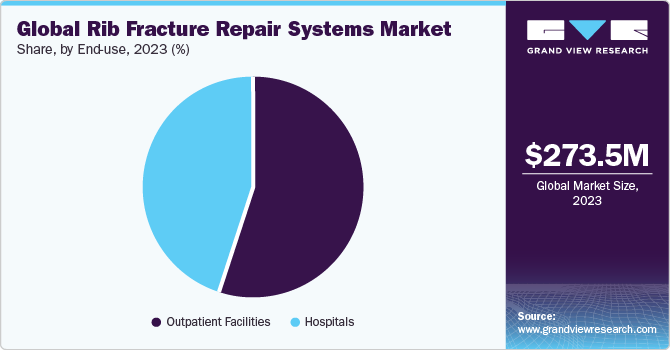
The hospital segment is expected to experience significant growth over the forecast period. Hospitals are investing in advanced technology and specialized staff to provide top-quality care for rib fractures, attracting patients seeking comprehensive treatment options. With an emphasis on advanced surgical techniques and multidisciplinary approaches, hospitals are striving to improve outcomes and patient satisfaction in the management of rib fractures while maintaining high levels of safety and efficiency. In addition, there is a growing focus on medical training programs that specialize in rib fracture management, providing healthcare professionals with the necessary skills to effectively treat these complex injuries. For instance, MatrixRIB Care Program is a comprehensive suite of tools and resources that includes case studies, care pathways, and educational materials designed to improve the treatment of patients with rib fractures. This program focuses on enhancing patient care, improving outcomes, and reducing costs, aligning with the Triple Aim objectives to provide optimal care for individuals with rib fractures. The training programs aim to enhance patient care and improve outcomes for individuals with rib fractures, contributing to the market growth.
Material Insights
The titanium material segment accounted for the largest revenue market share of 70.39% in 2023. Rising incidences of chest injuries and demand for advanced medical solutions are propelling market expansion. In addition, the increasing adoption of minimally invasive surgical techniques and increasing availability of titanium rib fracture repair systems are further fueling market growth. For instance, RibFixBlu, manufactured by Zimmer Biomet, features pre-contoured narrow titanium plates measuring 1.6 mm in thickness. These plates are equipped with self-drilling 2.4 mm locking screws that boast a distinctive cancellous screw design. RibFixBlu offers a range of plate options, including straight 8-hole plates and pre-contoured plates with 12, 16, and 24 holes, respectively. Moreover, enhanced biocompatibility, durability, and lighter weight properties of titanium rib plates also contribute to their growing popularity in medicine. These factors are expected to drive robust growth in the titanium material rib plate market in the foreseeable future.
PEEK material is anticipated to experience the fastest growth during the forecast period. The versatility of PEEK in medical applications has propelled its adoption. According to an NIH study published in March 2021, PEEK's compatibility with existing implant materials and fillers and its performance during surgical procedures adds to its appeal. The exceptional mechanical and physicochemical properties of PEEK and its composites further contribute to its success in the market. In addition, advancements in 3D printing technology have facilitated the development and production of complex implants using PEEK-based composites, expanding its potential applications.
Regional Insights
North America dominated the overall global market and accounted for 41.93% revenue share in 2023 due to the presence of a large number of major market players and growing healthcare expenditures. Furthermore, the high market share is also attributable to the relatively high incidence of traumatic injuries, including motor vehicle accidents, falls, and sports-related injuries, which can lead to rib fractures. This high incidence drives the demand for effective rib fracture repair solutions.
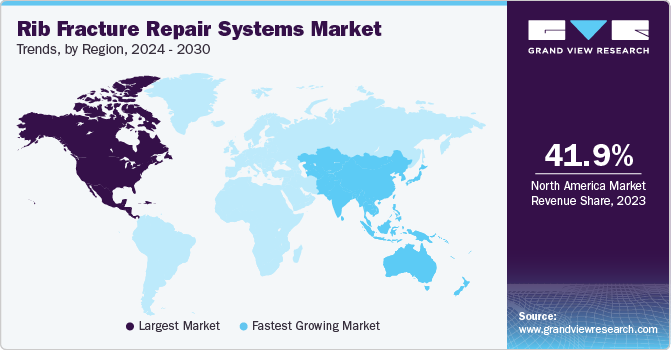
U.S. Rib Fracture Repair Systems Market Trends
Rib fracture repair systems market in the U.S. held a significant share of the North American market in 2023 due to the increasing number of accidents resulting in rib fractures. For instance, a study conducted by the NIH and published in May 2021 revealed that approximately 22,000 to 45,000 individuals in the U.S. are affected by rib fractures annually. The market growth can also be attributed to advancements in technology and the rising prevalence of sports injuries.
Canada rib fracture repair systems market is witnessing significant growth fueled by the growing cases of rib fractures and increasing government investment in advancing healthcare infrastructure.
The rib fracture repair systems market in Mexico is experiencing significant growth due to the increasing incidence of rib fractures. As the demand for effective treatment options rises, the market is expanding to accommodate the needs of patients seeking advanced solutions for rib fracture repair.
Europe Rib Fracture Repair Systems Market Trends
The rib fracture repair systems market in Europe is witnessing growth attributable to the increasing incidence of road accidents leading to rib injuries. Furthermore, the presence of major market players, such as Acumed LLC,Zimmer Biomet, andJohnson & Johnson Services Inc. (DePuy Synthes), is anticipated to create lucrative opportunities in Europe.
UK rib fracture repair systems market is one of the major markets in the region. Increasing cases of rib fractures are anticipated to boost market growth. For instance, according to a report published in 2021 by the Royal College of Surgeons of England, trauma to the chest is the cause of or contributes to up to 25% of annual trauma mortality. Rib fractures account for 55% of blunt chest trauma, and 10% of patients admitted to a major trauma center with blunt force trauma will have sustained one or more fractured ribs.
The rib fracture repair systems market in France is expected to grow significantly over the forecast period due to the increasing death rates associated with rib fractures. For instance, in a report from February 2020, the NIH found that in France, there were 562,094 new fractures reported. Women were the most affected, with an average age of 63.6 years. The incidence of fractures increased significantly after the age of 70. The study also noted a higher mortality rate associated with skull fractures at 12.9% and rib fractures at 4.9%. As the mortality rate continues to rise, there is a growing demand for advanced and effective rib fracture repair systems in France.
Asia Pacific Rib Fracture Repair Systems Market Trends
The rib fracture repair systems market in Asia Pacific is expected to grow at the fastest growth rate during the forecast period. This can be attributed to the growing motor vehicle accident cases in India and China. Furthermore, the rising elderly population and increasing rib fractures are also significantly driving regional growth.
China rib fracture repair systems market is expected to grow at the fastest rate during the forecast period driven by the country's innovative Value-Based Purchasing (VBP) program. The objective of the VBP program is to lower the cost of medical devices and medications by granting significant sales volumes to winning bidders, fostering competition, and lowering expenses. The National Healthcare Security Administration revealed the initiation of the 4th bulk purchasing program for medical devices in early December 2023.
The rib fracture repair systems market in India is expected to grow over the forecast period.Growing awareness pertaining to the early detection and treatment of rib fractures is anticipated to boost market growth. Moreover, the growing emergence of hospitals and specialized centers in the country will fuel market growth. For instance, in May 2024, SIMS Hospital in Chennai launched a specialized facility to address rib fractures and breastbone deformities. The Center of Excellence for Rib Cage Disorders is designed to assist patients dealing with rib fractures, flail chest, as well as complications such as subcutaneous and pneumothorax emphysema.
Latin America Rib Fracture Repair Systems Market Trends
The rib fracture repair systemsmarket in Latin America is experiencing significant growth attributed to various factors. The increasing awareness in the region about rib fractures has led to a substantial number of diagnosed cases, boosting the demand for early diagnosis of spinal issues. Furthermore, clinical education through webinars, conferences, and symposiums is becoming crucial in improving the adoption rate of rib fracture repair systems.
Brazil rib fracture repair systems market is experiencing significant growth owing to the increasing aging population. In addition, constantly improving healthcare infrastructure coupled with growing healthcare spending will further boost market growth. Moreover, the rise in sports-related injuries is contributing to the demand for rib fracture repair systems
MEA Rib Fracture Repair Systems Market Trends
Therib fracture repair systems marketin MEA is experiencing significant growth over the forecast period, attributed to the increasing number of orthopedic hospitals in the region. As the healthcare infrastructure develops and access to specialized orthopedic care improves, the demand for advanced rib fracture repair systems is rising. This expansion of orthopedic facilities drives market growth and provide patients with enhanced treatment options for rib fractures in the Middle East and Africa.
Saudi Arabia rib fracture repair systems market is anticipated to expand in the forecast period due to the rising investment in healthcare infrastructure. With the increasing focus on improving healthcare facilities and services, there is a growing demand for advanced rib fracture repair systems to provide effective treatment options for patients with rib fractures. For instance,as part of Vision 2030, the Saudi Arabian Government is committed to investing more than USD 65 billion towards enhancing the healthcare infrastructure within the country. This investment is driving market growth and innovation in the field.
Key Rib Fracture Repair Systems Company Insights
The competitive scenario in the rib fracture repair systems market is highly competitive, with key players such as Acumed LLC; Johnson & Johnson; Stryker; Zimmer Biomet holding significant positions. The major companies are undertaking various organic as well as inorganic strategies such as new product development, collaborations, acquisitions, mergers, and regional expansion to serve the unmet needs of their customers.
Key Rib Fracture Repair Systems Companies:
The following are the leading companies in the rib fracture repair systems market. These companies collectively hold the largest market share and dictate industry trends.
- Zimmer Biomet
- Johnson & Johnson Services, Inc.
- Acumed, LLC
- Jeil Medical Corporation
- Waston Medical Co., Ltd.
- NEURO FRANCE Implants
- KLS Martin Group
- Stryker Corporation
- Able Medical Devices
Recent Developments
-
In January 2024, Able Medical Devices announced the FDA clearance for its Valkyrie RIB System, which significantly strengthens their offerings in the cardiothoracic and trauma domains.
-
In September 2019, Zimmer Biomet launched its RibFix advantage intrathoracic fixation system. It is one of the pioneering FDA-approved minimally invasive systems for fixing, stabilizing, and fusing rib fractures and osteotomies in both normal and osteoporotic bone.
-
In November 2018, SIG Medical revealed that its AdvantageRib Anterior System received 510(k) clearance from the U.S. FDA, K182179. This marked the second rib fracture system that SIG Medical brought to market.
Rib Fracture Repair Systems Market Report Scope
|
Report Attribute |
Details |
|
Market size value in 2024 |
USD 290.02 million |
|
Revenue forecast in 2030 |
USD 382.41 million |
|
Growth rate |
CAGR of 4.7% from 2024 to 2030 |
|
Actual data |
2018 - 2023 |
|
Forecast data |
2024 - 2030 |
|
Quantitative units |
Revenue in USD million/billion and CAGR from 2024 to 2030 |
|
Report coverage |
Revenue forecast, company ranking, competitive landscape, growth factors, and trends |
|
Segments covered |
Product, material, end-use, region |
|
Regional scope |
North America; Europe; Asia Pacific; Latin America; MEA |
|
Country scope |
U.S.; Canada; Mexico; UK; Germany; France; Italy; Spain; Denmark; Sweden; Norway; Japan; China; India; Australia; South Korea; Thailand; Brazil; Argentina; South Africa; Saudi Arabia; UAE; Kuwait |
|
Key companies profiled |
Zimmer Biomet; Johnson & Johnson Services, Inc. (DePuy Synthes); Acumed, LLC; Jeil Medical Corporation; Waston Medical Co., Ltd.,; NEURO FRANCE Implants; KLS Martin Group; Stryker Corporation; Able Medical Devices |
|
Customization scope |
Free report customization (equivalent up to 8 analysts working days) with purchase. Addition or alteration to country, regional & segment scope. |
|
Pricing and purchase options |
Avail customized purchase options to meet your exact research needs. Explore purchase options |
Global Rib Fracture Repair Systems Market Report Segmentation
This report forecasts revenue growth at global, regional, and country levels and provides an analysis on the latest industry trends and opportunities in each of the sub-segments from 2018 to 2030. For this study, Grand View Research has segmented the rib fracture repair systems market report based on of product, material, end-use and region:
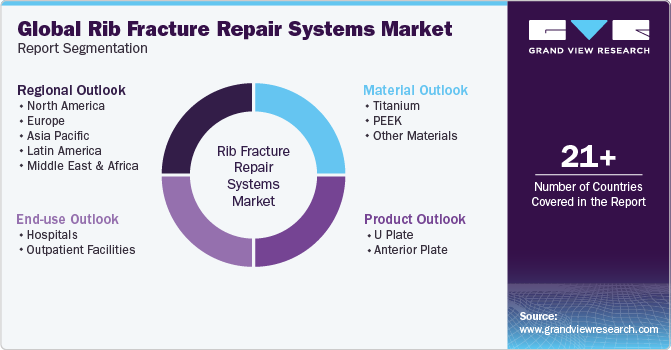
-
Product Outlook (Revenue, USD Million, 2018 - 2030)
-
U Plate
-
Anterior Plate
-
-
Material Outlook (Revenue, USD Million, 2018 - 2030)
-
Titanium
-
PEEK
-
Other Materials
-
-
End-use Outlook (Revenue, USD Million, 2018 - 2030)
-
Hospitals
-
Outpatient Facilities
-
-
Regional Outlook (Revenue, USD Million, 2018 - 2030)
-
North America
-
U.S.
-
Canada
-
Mexico
-
-
Europe
-
UK
-
Germany
-
France
-
Italy
-
Spain
-
Denmark
-
Sweden
-
Norway
-
-
Asia Pacific
-
Japan
-
China
-
India
-
Australia
-
South Korea
-
Thailand
-
-
Latin America
-
Brazil
-
Argentina
-
-
Middle East Africa
-
South Africa
-
Saudi Arabia
-
UAE
-
Kuwait
-
-
Frequently Asked Questions About This Report
b. The global rib fracture repair system market size was estimated at USD 273.54 million in 2023 and is expected to reach USD 290.02 million in 2024.
b. The global rib fracture repair system market is expected to grow at a compound annual growth rate of 4.7 % from 2024 to 2030 to reach USD 382.41 million by 2030.
b. North America rib fracture repair systems market dominated the overall global market and accounted for the 41.9% revenue share in 2023 due to the presence of a large number of major market players and growing healthcare expenditure.
b. Some key players operating in the market include Zimmer Biomet, Johnson & Johnson Services, Inc., Acumed, LLC, Jeil Medical Corporation, Waston Medical Co., Ltd., NEURO FRANCE Implants, KLS Martin Group, Stryker Corporation, Able Medical Devices
b. Key factors that are driving the market growth include increasing incidence of rib fractures, technological advancements, and growing demand for minimally invasive surgical procedures.
We are committed towards customer satisfaction, and quality service.
"The quality of research they have done for us has been excellent."




